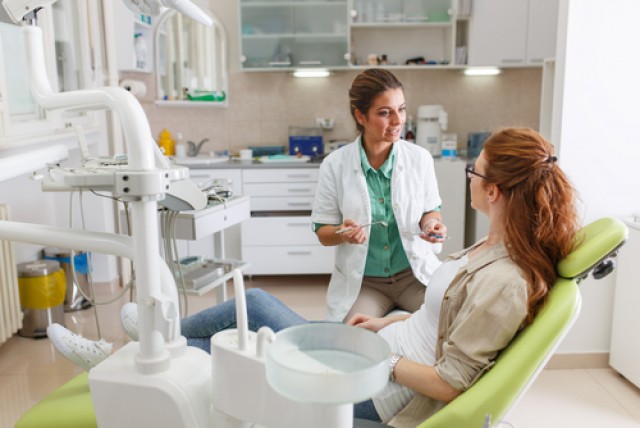Tips for planning your patient’s next dental appointment
Planning next dental visits

When we have a note in the computer prior to the appointment, the assistant and the
doctor can check the notes and know exactly what the patient needs that day.
And the front desk can check the notes and know exactly what to tell the patient if they’re on the phone and the patient is asking to be reminded what they need to do for the next appointment.
If there’s a need for the treatment coordinator to estimate a copay before the
What next visit notes to write down after each appointment
So, after the initial exam with the patient and for every subsequent appointment when the patient comes in, it’s a good idea to write down what’s planned for the next step for restorative and hygiene appointments.
At the end of your notes, write down which restorative procedure is planned next.
Is it a filling, is it a crown? Just write down which procedure type is planned and which tooth or which surfaces are planned.
Is it a crown on Number two, is it a number two composite that’s planned?
You can also write down how much time is needed for that procedure.
Do you need 30 minutes?
Do you need an hour?
Or, you could add that all the treatment plans are completed.

Always make sure your patient is scheduled for their next cleaning appointment

And you should also add a second line to make sure the patient is currently scheduled for a cleaning appointment with the hygienist.
Many appointments are made for cleanings months in advance when leaving their last cleaning appointment, so it’s important to have an appointment scheduled for all patients to have some time saved for them, too.
The best thing is to go ahead and write down the date of that hygiene appointment. That way you know that the schedule has been checked to be sure that we have an appointment.
We can’t just say a patient is going to return for cleaning. If we write down July 30th as the date the patient has a cleaning scheduled, we know that we’ve taken the time to check and make sure that the patient does indeed have an appointment scheduled for a cleaning already.
Or at least we write some explanation why the patient declined a cleaning appointment to be scheduled.
The other reason it’s nice to write down the date is that if the patient cancels their cleaning later, we still have a record in the notes that we had made them a prior cleaning appointment.
Adding extra notes to help streamline the next appointment and further improve patient experience
And finally, a third part to these notes, you can add extra notes just to help you remember before the next visit.
Items such as sending a pre-authorization or checking benefits for a major dental procedure, that may cost over a certain dollar amount.
Perhaps there’s a crown or a denture that’s planned in the future and we want to check the benefits.

We can make a note that we’re sending a pre-authorization or checking benefits for this denture with the patient’s insurance.
This way we will be reminded when they come in at their next visit that we need to have that information ready when the patient asks if we haven’t already called them beforehand.
Planning next dental visits to save time and be more efficient
But whatever auto note you use for your clinical dental notes at the end, it’s good to add the date of the next hygiene visit as a line. and then also any dental plans below that as a minimum.
These two things will help you save time and be more efficient ahead of your next patient appointment.


Promociones Jugabet Per? Promociones Jugabet Per? .
вывод из запоя круглосуточно ростов-на-дону http://www.sait.anihub.me/viewtopic.php?id=5674/ .
алкоголизм лечение вывод из запоя ростов http://honey.ukrbb.net/viewtopic.php?f=45&t=16673/ .
вывод из запоя в ростове-на-дону вывод из запоя в ростове-на-дону .
анонимный вывод из запоя ростов анонимный вывод из запоя ростов .
Покупка диплома о среднем полном образовании: как избежать мошенничества?
Как быстро получить диплом магистра? Легальные способы
forum-pravo.com.ua/member.php?u=10249
срочный вывод из запоя ростов http://www.domsadremont.ukrbb.net/viewtopic.php?f=3&t=901 .
вывод из запоя круглосуточно https://www.stranaua.ukrbb.net/viewtopic.php?f=2&t=59741 .
Jugabet registro Jugabet registro .
алкоголизм лечение вывод из запоя ростов http://mediaworld.ukrbb.net/viewtopic.php?f=49&t=5431/ .
вывод из запоя цены на дому ростов http://www.ximki.ukrbb.net/viewtopic.php?f=12&t=3696 .
вывод. из. запоя. анонимно. ростов. superstar.ukrbb.net/viewtopic.php?f=3&t=680 .
Juegos de casino Jugabet https://www.jugabet777.com .
вывод из запоя цена ростов вывод из запоя цена ростов .
вывод из запоя на дому ростов-на-дону honey.ukrbb.net/viewtopic.php?f=45&t=16673 .
вывод из запоя на дому ростов на дону ximki.ukrbb.net/viewtopic.php?f=12&t=3696 .
вывод из запоя на дому ростов цены http://www.superstar.ukrbb.net/viewtopic.php?f=3&t=680 .
Jugabet c?digo promocional Jugabet c?digo promocional .
вывод из запоя на дому в ростове http://www.tatuheart.ukrbb.net/viewtopic.php?f=8&t=15061 .
вывод из запоя ростов-на-дону вывод из запоя ростов-на-дону .
анонимный. вывод. из. запоя. ростов. https://ekonomimvmeste.ukrbb.net/viewtopic.php?f=14&t=65331/ .
Здесь можно преобрести сейф цена сейф москва
Удивительно, но купить диплом кандидата наук оказалось не так сложно
Приобретение диплома ПТУ с сокращенной программой обучения в Москве
Официальная покупка диплома вуза с сокращенной программой обучения в Москве
Купить диплом в России, предлагает наша компания
Приобретение школьного аттестата с официальным упрощенным обучением в Москве
Как официально купить аттестат 11 класса с упрощенным обучением в Москве
Как официально купить аттестат 11 класса с упрощенным обучением в Москве
Купить смартфон https://elektronik-art.ru по низкой цене с быстрой доставкой!
жЈи¦Џе“Ѓгѓђг‚¤г‚ўг‚°гѓ©йЊ гЃ®жЈгЃ—い処方 – シアリスジェネリック йЂљиІ© г‚їгѓЂгѓ©гѓ•г‚Јгѓ«йЂљиІ©
Тут можно преобрести шкаф оружейный купить оружейные сейфы и шкафы для охотничьего ружья
Как получить диплом техникума с упрощенным обучением в Москве официально
reddit priligy This medication can affect your gall bladder and cause gallstones or biliary abnormalities including jaundice in patients who use it over a long period of time
. https://www.gbwhatspk.com/unveiling-romance-the-magic-of-wedding-hotels-in-pattaya/ .
вывод из запоя в стационаре ростов-на-дону http://www.ukroenergo.ukrbb.net/viewtopic.php?f=13&t=21376 .
вывод из запоя ростов на дону на дому вывод из запоя ростов на дону на дому .
. https://nationrussia97.werite.net/a-couples-guide-to-enjoying-sex-videos-together .
. http://www.ferrousmetalworld.mee.nu/general_points_to_learn_about_junk_metal_recycling_where_possible#c943 .
. http://www.woorkup.com/wordpress-disable-automatic-updates/#comment-267834 .
. https://www.goodreads.com/user/show/169883464-ronan-farrow/ .
вывод из запоя стационар ростов http://www.advance2.ukrbb.net/viewtopic.php?f=2&t=775 .
вывод из запоя в стационаре ростов https://gaslo.ukrbb.net/viewtopic.php?f=13&t=3407 .
. http://loveeverydragon.com/members/pintniece56/activity/3330/ .
. https://articlescad.com/understanding-sexual-preferences-through-film-581646.html .
. http://www.library.kemu.ac.ke/kemuwiki/index.php/User:Norwoodyilsgffffrbbbbbb .
вывод из запоя на дому ростов http://www.www.rolandus.org/forum/viewtopic.php?p=106422 .
. https://squareblogs.net/subwayboy04/a-deep-dive-into-the-educational-side-of-sex-videos .
. http://mensvault.men/story.php?title=get-more-information-about-xxx-con#discuss .